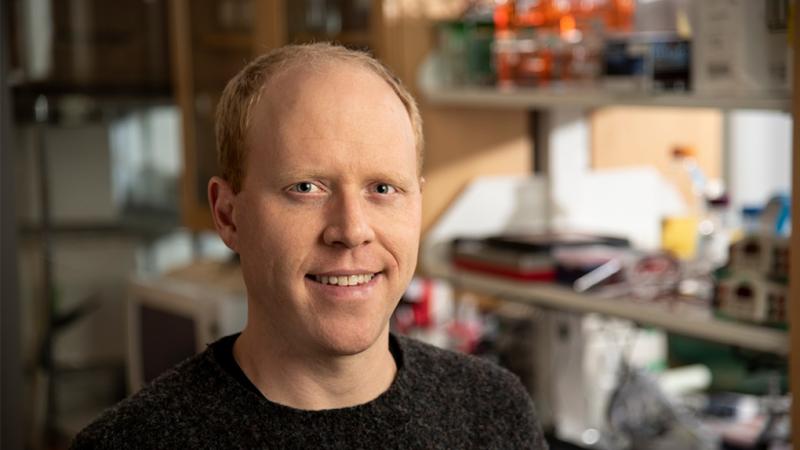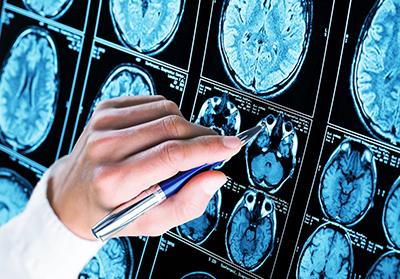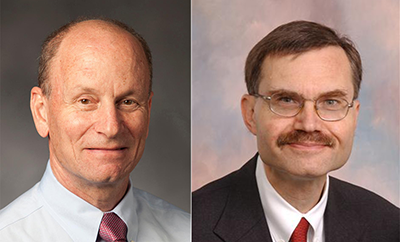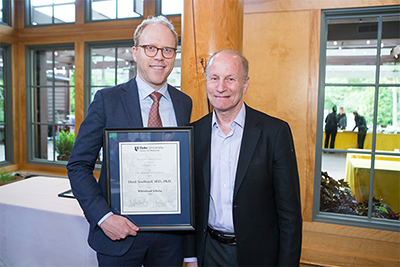
A New Day for People with Drug-Resistant Epilepsy
Neurosurgeon Derek Southwell, MD, PhD, has been at Duke only since 2019, but he has already expanded the options for epilepsy treatment in the state of North Carolina. As both clinician and researcher, Southwell works every day to improve the lives of people with this challenging condition, in which nerve cell activity in the brain is disturbed, causing seizures.
Southwell’s clinical practice at Duke is distinguished by a recent surgical advance in epilepsy therapy. Although the surgical treatment of epilepsy has a long history (first performed in the 19th century) there are new, life-changing procedures available for drug-resistant epilepsy. Unfortunately, there is also a lot of work to be done in building awareness of these.
Deep Brain Stimulation
One of these new treatments is deep brain stimulation (DBS). Most, but not all patients will experience a great improvement in quality of life after DBS, with an average reduction in seizure frequency of approximately 70-75%.
In 2019, Southwell performed the first DBS epilepsy procedure in North Carolina. Since then, the physician-scientist and his colleagues at Duke have used DBS to treat more than 15 patients with drug-resistant epilepsy.

At that time, DBS had only recently been approved by the Food and Drug Administration as a surgical treatment for drug resistant epilepsy, and it represented another way of approaching epilepsy surgery.
“Epilepsy treatments like resection or laser ablation are typically used to remove or damage the specific area of the patient’s brain where seizures originate,” said Southwell. “Those surgeries require us to have a clear picture of where the patient’s seizures originate. DBS does not directly target the brain area or areas that originate seizures, rather, it targets a central region of the brain (the thalamus) that connects to them.”
DBS involves the placement of small wires into the brain, which alter abnormal brain activity patterns by delivering small electrical impulses. By virtue of the central connectivity of the thalamus, deep brain stimulation of the thalamus reduces the likelihood that its connected areas produce or spread seizure activity.
“DBS can be applied in cases where it’s difficult to fully identify where and how seizures originate,” he said. “It is also a valuable option in cases where the seizure onset areas are known, but they can’t be safely removed, for example.”
Reaching Those Who Can Benefit
Today, DBS therapy is much more commonly used to treat Parkinson’s disease, tremor, and dystonia than epilepsy. This shortfall has much to do with patient awareness and with specific challenges faced by patients with epilepsy.
“Physicians and patients are, for various reasons, often unaware of surgical options for epilepsy,” said Southwell. As soon as the FDA approved the therapy, he was eager to educate patients and medical professionals. He spent time traveling North Carolina (pre-pandemic) with Duke referral coordinators, providing information and education in both urban and rural settings.

And for many people with epilepsy, accessing advanced medical centers is simply too difficult. Epilepsy can have a huge social and economic impact on patients and their families, Southwell explained. It may occur as a result of a genetic disorder or an acquired brain injury, such as a trauma or stroke. Some people with epilepsy may suffer from memory, mood, or cognitive difficulties, due to the seizures’ effects on the brain and the medications used to control the seizures. They are at high risk of injury due to seizures, and they may not drive, making it difficult to work and frequently requiring the close care of loved ones.
Steve Lisberger, PhD, chair of the Duke Department of Neurobiology, is not surprised at the time and thought Southwell devotes to increasing awareness of advanced therapies for epilepsy. “He is not only a brilliant scientist but a thoughtful physician and a proactive and effective advocate for all patients,” he said.
At the Bench
Lisberger was instrumental in recruiting Southwell to Duke from the University of California San Francisco, where he was involved in the earliest work on interneuron transplantation -- work that he continues today at Duke.
Southwell was recruited to Duke as one of 12 “Translating Duke Health Scholars” in 2019. The Translating Duke Health initiative supports researchers who are doing translational research in key areas including cancer, brain, immunology, and children’s health, and provides a gateway to external grant funding.
“Derek is exploring how transplantation of interneurons can be made safe and effective as a therapy for epilepsy,” said Lisberger. “If successful, his pioneering therapeutic approach holds the potential to provide very specific and permanent cures for epilepsy without the side effects of medications or the risks of surgery.”
Interneurons are brain cells that provide inhibitory signals to partner brain cells. Southwell and others have shown that interneurons can be transplanted into the brain, where they modify the neural circuits of the recipient. By grafting new inhibitory interneurons into the recipient brain, transplantation has been used to reduce the activity patterns that give rise to seizures.

The research so far has been conducted using animal models. “We’re working to better understand basic aspects of how these cells can be introduced into the brain, how they incorporate there and how they affect function,” Southwell said. “We want to understand the practical considerations and obstacles need to overcome in order to safely and effectively translate this therapy to patients.”
The technology has implications beyond epilepsy. “There are other conditions marked by the deficient function of interneurons, and there are others that may be corrected by the addition of new functional inhibition,” he said. These conditions include neuropsychiatric disorders like autism and schizophrenia, as well as others such as stroke and Alzheimer’s. Adds Duke Neurosurgery Chair Allan Friedman, MD, "Dr. Southwell's work has so much potential to restore function to patients who have lost function secondary to stroke, trauma, or neurological diseases."
How To Become A Physician Scientist
Southwell grew up in Minneapolis, Minnesota, and became involved in biomedical research in high school, first-authoring a publication on research he did during his senior year. After high school, he received his BS degree from Massachusetts Institute of Technology. He received his MD, PhD, and neurosurgical residency training at the University of California San Francisco.

By all accounts, the public-school curriculum he was afforded in Minneapolis was remarkable, and it shaped his future in a meaningful way. In a program that continues today, students were paired with outside professional mentors, leaving their classrooms in the afternoons to study in various fields of interest – music production, aviation, public health, and so on. Southwell was paired with Joan Bechtold, PhD, who was director of the Orthopedics Biomechanics Lab and a future president of the Orthopedic Research Society. Today, she is vice chair for research in the Department of Orthopedic Surgery at the University of Minnesota.
“Joan really emphasized the values of translational research — science that could impact patient care,” said Southwell. “That’s a mindset I’ve carried with me since.”
In spring 2019, he was named a Whitehead Scholar in the Duke University School of Medicine. The Whitehead Scholars are faculty – usually junior faculty -- who have exceptional potential for research in the biomedical sciences. He has since received the Neurosurgery Research Career Development Program K12 award from the NIH as well as the Klingenstein-Simons Foundation Award for Neuroscience. This award is one of the most prestigious fellowships for young investigators in neuroscience.
Carol Harbers is the Director of Communications for the Department of Neurosurgery.
